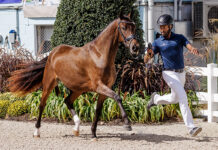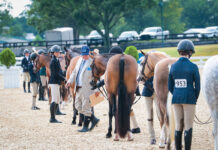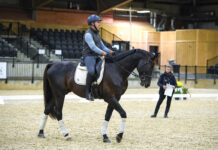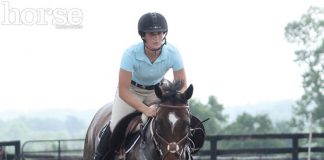What’s wrong with this scenario? Why aren’t the horse and rider on the same wavelength? There are several possible reasons. Horses can run from the pain of an ill-fitting saddle or bit, problems with their teeth or a wide variety of other physical ailments. But if pain issues are ruled out, the answer may lie in good training and better riding. We asked United States Equestrian Federation “S” dressage judge and sporthorse “R” judge Jayne Ayers for some tips on slowing things down. In addition to a long judging career, Jayne has competed through Grand Prix and has been long and short listed for the United States Equestrian Team. She currently trains dressage riders out of her facility, Hearthstone Farm Inc., in Dousman, Wis., and in clinics around the country.
Half-Halt If your horse is running through your downward requests, work on your half-halt. “The half-halt is used to prepare and ask for transitions,” says Jayne Ayers, a longtime dressage judge, instructor and competitor, who trains out of her Hearthstone Farm Inc. in Dousman, Wis. She explains that during the half-halt the rider very briefly “blocks” the swing of the horse’s back. “The rider accomplishes this by tightening the stomach and back muscles for a second. The rider’s seat bones feel heavier against the saddle for that instant. The rider should not pinch with the knees, thighs or buttocks muscles. It may take several repetitions before the horse understands, but eventually most horses will do the transition requested.” Many riders make the mistake of holding the half-halt too long, waiting for a reaction from the horse. Jayne explains that the reaction actually comes with the release of the rider’s blocking motion. “If the horse doesn’t do what you ask, release and ask again.” It’s important to repeat rather than sustain, Jayne says. |
So you say your horse likes to rush or get quick—but what does that really mean? Jayne says you first have to figure out exactly what is happening: Does your horse ignore your aids and resist downward transitions? Is he on the forehand—heavy and pulling on the reins? Is his tempo faster than you are comfortable with, even though it may be right for him? Are his strides bigger and more powerful than you can comfortably sit? Or is he running in a tempo that is faster than he should? Jayne explains that all of these issues can be resolved through good riding, but you need to understand what’s going on in order to fix it.
“Unfortunately, horses often get blamed for poor performance,” Jayne says. In fact, it’s commonly the rider who’s at fault. If your horse is resisting your request to make a transition down, he may not understand what you’re asking. Jayne says the likely problem is lack of clear, consistent aids from the rider. “The horse must be confident and clear about what is expected of him,” she explains. “Dressage is all about clear communication, from both the horse and the rider points-of-view.”
But many people don’t ride well enough to give clear aids. “If the rider’s seat, legs and hands are constantly moving, the communication cannot be clear,” Jayne warns. “To the horse, it’s chaotic—there’s too much static.” If your horse has learned to put up with the chaos, he’s probably learned to tune you out—he stopped listening to your constant “chatter,” or worse, he runs from it.
“Work on being clearer with your requests,” Jayne says. Keep things simple. Focus on the walk, halt and turning—then try an upward transition to trot. If the horse’s tempo gets too quick, go back to walk.
The horse’s tempo is his stride rate, or strides per minute. Regardless of gait, Jayne says your horse’s tempo should be comfortable for him. “A pony has a faster tempo than a big, elastic-moving warmblood. The horse’s tempo is correct when he moves energetically forward, with relaxation and swinging in his back. It shouldn’t feel too pokey or like he’s running off.” A horse that rushes might not have an appropriate tempo.
What Are You Telling Your Horse?
In order to have a harmonious partnership with your horse, you must have a good seat. Jayne says work on the longeline is very effective for developing the correct position and improving your aids. And it’s not just for novices. “Even my FEI-level riders work on the longe on a regular basis. We work on specific aids, such as half-halt, transitions, invisible aids, et cetera.”
Jayne says that whether riders are working on the longe or off, they’ve got to be aware of what they are “saying” to their horses. Take the posting trot—you can slow the horse’s tempo by slowing down your posting rate. “Many riders post faster than the horse’s trot,” Jayne says. “If you slow down the motion of your seat, the horse will come right back to you.”
Riders should stay at the rising trot until they can sit correctly. You have to be able to follow the horse’s motion with your seat, without interference, before moving on to sitting trot. “At the sitting trot, the rider’s hips follow the motion of the horse, as if sitting on a bouncing beach ball,” Jayne says. If your seat, legs and hands are all over the place during sitting trot, your horse can’t receive clear aids. “The horse doesn’t know if you want more bend, or a transition up or a faster trot.”
Riders need to have a good base of support to achieve a good sitting trot. To improve this base, Jayne has her students trot circles while standing in the stirrups and leaning slightly forward. In the beginning riders can hold on to the horse’s mane or rest their hands on the neck, but must eventually maintain their balance without holding on.
Jayne also says that the “lateral placement” of the rider’s weight affects the horse’s tempo. When riding a curve, for example, whether it’s an arena corner or a circle, many riders place too much weight in the outside stirrup. “The weight is in the wrong place ‘laterally,’ ” she says. “I’ve seen horses that bolt as a result of this.” Instead, keep your weight in the inside stirrup when riding an arc or curve to keep the horse in balance. To keep from leaning in and throwing your horse off balance, move your outside shoulder slightly forward to parallel your horse’s shoulders.
Gripping the horse with your legs and knees causes increased speed as well. The goal is to ride with your leg lightly and quietly against the horse. While a death grip will make your horse nervous, not enough leg can cause anxiety as well. Some riders make the mistake of riding with their legs “off” the sensitive horse that has a tendency to get quick. But this often leads to nervous anticipation and running off when the rider does make contact or inadvertently bumps the horse.
Try to put yourself in your horse’s place: Think about how you react when someone is threatening to tickle you. You wiggle and squirm to avoid those tickles. Each time the tickler nears, you tense up—you’re anticipating. If you ride with your legs off the horse, you can cause this same sort of anticipation. You’re also far more likely to bump him with your heels because your legs aren’t steady. Instead, keep your legs quietly against the horse to help eliminate nervous anticipation. Also remember to make your leg cues quick, precise and consistent, not prolonged, harsh or erratic.
Quiet, Please
Your hands also affect your horse’s tempo. “The rider must have light, elastic contact,” Jayne says. Some riders use the horse’s mouth as a “seat belt,” or they bump his mouth inadvertently. “Many horses will run from a tight, unyielding hand. You must learn to sit independently: Your arms and hands must operate independently from the rest of your body.”
Even if your horse learns to accept unforgiving hands, you are teaching him a bad habit that will cost you during your next dressage test. A big fault Jayne sees in the show-ring is heavy hands. “I see a lot of horses that are ‘pulled’ together. I want to see the horse carry himself, flowing freely forward, not heavy on the reins. Restricting the horse’s motion with heavy hands hollows his back, and shortens his neck and stride. I want to see light contact.”
When it comes to hands, Jayne says that the walk and canter are often difficult gaits to ride well. Your horse needs to use his head and neck for balance at these gaits, so your hands need to follow his head nod—the up and down movement. Riders sometimes constrict the horse’s head, particularly at canter, because they are afraid the horse will run off. When riders do this, a sensitive horse often will try to escape entrapment by the reins, Jayne warns.
To help learn the correct feel of following the horse’s movement, here’s an exercise Jayne uses: With a horse and rider halted directly in front of her, Jayne takes the reins, behind the bit, and mimics the up and down movement of the horse’s head during the walk and canter. “I take the reins and have the rider follow my hands.” Since Jayne is controlling the reins, she can feel the exact amount of pressure being applied by the rider and give corrections as needed. The amount of weight the rider has in the reins “should be about that of [holding a] candy bar during the walk, a little more at canter, but not much more,” Jayne explains.
Not only do you have to learn to follow the horse’s movement with your hands at walk and canter, you have to keep them quiet during trot. An exercise Jayne uses for steadying riders’ hands at trot is to have them ride with a “grab strap” during posting trot. Similar to a bucking strap, although a little longer, the grab strap is attached to the saddle. During posting trot the rider holds the reins in the normal way, but the pinkie fingers go under the strap. Jayne says riders can focus on steady hands by keeping their pinkies quietly under the strap—the pinkies shouldn’t pop up against the strap or come out from under it.
Return to the Fundamentals
Before you can move up in the dressage levels, there must be relaxation in your horse—both mentally and physically. A horse that rushes isn’t relaxed. “The horse must be supple, swinging through his back,” Jayne says. Also, your horse must have clear acceptance of the bit and the aids. Once you have these elements, you’re definitely on the right path.
*This article was featured in Horse Illustrated – April 2006 Subscribe today!







I love this article. It is so on target. Most horse performance problems relate directly to poor rider performance. This article points out the horse’s specific responses to specific poor riding habits. And then kindly offers clear advice to correct the problem. Read this, then ride with this in mind. Let your horse be your toughest instructor. Listen well enough, and he will teach you how to do it right.
Thanks,my horse always rushes…this helped!
I love this article, my Quarter Horse is very forward moving. I’ve got him at a comfortable trot I’m still working on the canter.I know what you mean when people ride with their legs off. My horse used to take off with someone on his back if they didn’t close their calves on him.(Horse Illustrated is the best!)
thanks!!
Thanks.
Thanks, this is great advice!
Good tips!
wow this helped a lot! i found out that i was too heavy with my hands and now my ottb is more realxed.
This info really helps. I love reading all the articles!
this really helps… thanks
My horse speeds up like crazy after a jump i havent fallin of yet but its geting dangerous!!!
Good help.
Great help, thanks so much Horse Channel! Keep it up!
I don’t like English style riding. Why do people like it so much?
‘Never the horse, always the rider.’ This is a quote i try to keep in mind while working with horses. Whenever they do something incorrectly, I try and think about what I’m doing wrong. Seeing things from the horses’ POV is one of the most important things a rider can learn to do. Thanks again for the great tips Horse Channel!